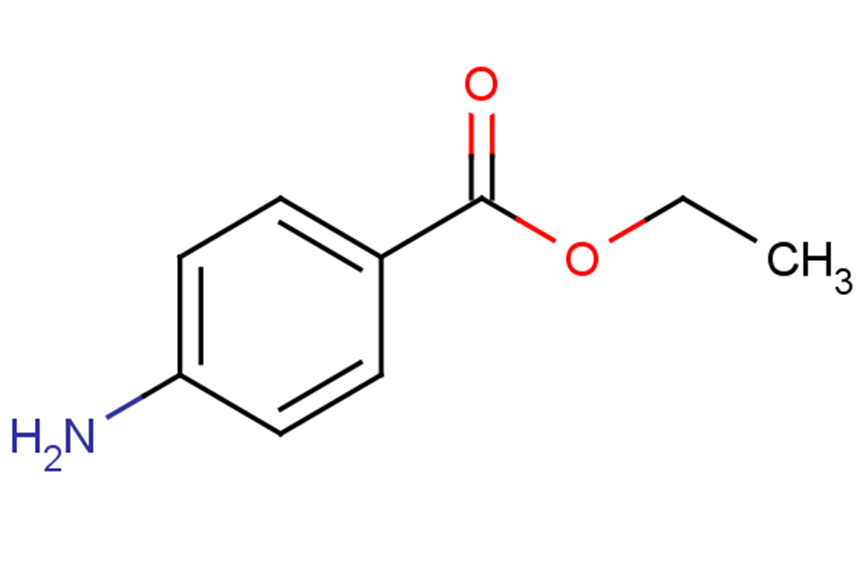
Benzocaine
CAS No. 94-09-7
Benzocaine( —— )
Catalog No. M24992 CAS No. 94-09-7
Benzocaine is a surface anesthetic that acts by preventing transmission of impulses along nerve fibers and at nerve endings.
Purity : >98% (HPLC)
 COA
COA
 Datasheet
Datasheet
 HNMR
HNMR
 HPLC
HPLC
 MSDS
MSDS
 Handing Instructions
Handing Instructions
| Size | Price / USD | Stock | Quantity |
| 500MG | 38 | In Stock |


|
| 1G | Get Quote | In Stock |


|
Biological Information
-
Product NameBenzocaine
-
NoteResearch use only, not for human use.
-
Brief DescriptionBenzocaine is a surface anesthetic that acts by preventing transmission of impulses along nerve fibers and at nerve endings.
-
DescriptionBenzocaine is a surface anesthetic that acts by preventing transmission of impulses along nerve fibers and at nerve endings.(In Vitro):Benzocaine blocks μ1 wild-type Na+ currents in a dose-dependent Manner. The Benzocaine concentration that inhibits 50% of Na+ currents (IC50) is estimated to be about 0.8 mM when a test potential of +30 mV is applied. The slope of the h∞ curve is also significantly reduced by benzocaine (from 6.6 to 9.9 mV). Mutation of μ1-N1584A also significantly increases the potency of Benzocaine. At 1 mM, Benzocaine blocks about 55% of wild-type Na+ current but about 95% of μ1-N1584A mutant current. Benzocaine also appears to bind more strongly to its LA receptor in the N1584A mutant than in the wild type. The inhibition of Ca2+ uptake occurres at lower Benzocaine concentration (IC50=40.3±1.2mM) than that affecting the enzymatic activity. (In Vivo):Benzocaine is topically applied to the following species: dogs, domestic shorthair cats, Long-Evans rats, Sprague-Dawley rats, ferrets, rhesus monkeys, cynomolgus monkeys, owl monkeys, New Zealand White rabbits, miniature pigs, ICR mice, C3H mice, and C57BL/10SnJ mice. All animals, except mice and rats, receive a 2-second spray to the mucous membranes of the nasopharynx for an estimated dose of 56 mg. A 2-second spray to rodents' oral mucous membranes delivers too great a volume of fluid for these animals. The study is repeated in dogs several months later to confirm low response. Response to Benzocaine spray is observed in most animals tested, with response peaking between 15 and 30 minutes after dosing.
-
In VitroBenzocaine blocks μ1 wild-type Na+ currents in a dose-dependent Manner. The Benzocaine concentration that inhibits 50% of Na+ currents (IC50) is estimated to be about 0.8 mM when a test potential of +30 mV is applied. The slope of the h∞ curve is also significantly reduced by benzocaine (from 6.6 to 9.9 mV). Mutation of μ1-N1584A also significantly increases the potency of Benzocaine. At 1 mM, Benzocaine blocks about 55% of wild-type Na+ current but about 95% of μ1-N1584A mutant current. Benzocaine also appears to bind more strongly to its LA receptor in the N1584A mutant than in the wild type. The inhibition of Ca2+ uptake occurres at lower Benzocaine concentration (IC50=40.3±1.2mM) than that affecting the enzymatic activity.
-
In VivoBenzocaine is topically applied to the following species: dogs, domestic shorthair cats, Long-Evans rats, Sprague-Dawley rats, ferrets, rhesus monkeys, cynomolgus monkeys, owl monkeys, New Zealand White rabbits, miniature pigs, ICR mice, C3H mice, and C57BL/10SnJ mice. All animals, except mice and rats, receive a 2-second spray to the mucous membranes of the nasopharynx for an estimated dose of 56 mg. A 2-second spray to rodents' oral mucous membranes delivers too great a volume of fluid for these animals. The study is repeated in dogs several months later to confirm low response. Response to Benzocaine spray is observed in most animals tested, with response peaking between 15 and 30 minutes after dosing.
-
Synonyms——
-
PathwayEndocrinology/Hormones
-
TargetMRP
-
RecptorMRP1| LCE 1| Sodium Channel
-
Research Area——
-
Indication——
Chemical Information
-
CAS Number94-09-7
-
Formula Weight165.19
-
Molecular FormulaC9H11NO2
-
Purity>98% (HPLC)
-
SolubilityDMSO:31 mg/mL (187.7 mM);Ethanol:31 mg/mL (187.7 mM)
-
SMILESCCOC(=O)c1ccc(N)cc1
-
Chemical Name——
Shipping & Storage Information
-
Storage(-20℃)
-
ShippingWith Ice Pack
-
Stability≥ 2 years
Reference
1.Wang GK, et al. Pflugers Arch, 1998, 435(2), 293-302.
molnova catalog



related products
-
LY-402913
LY-402913 is a selective inhibitor of the multidrug resistance protein (MRP1).
-
Ceefourin 1
Ceefourin 1 is a highly selective multidrug resistance protein 4 (MRP4) inhibitor.Ceefourin 1 and Ceefourin 2, that inhibit transport of a broad range of MRP4 substrates.
-
Licoisoflavone A
Licoisoflavone A is a potential MRP inhibitor, it shows inhibitory effects on copper-induced protein oxidative modification of mice brain homogenate in vitro.



 Cart
Cart
 sales@molnova.com
sales@molnova.com


